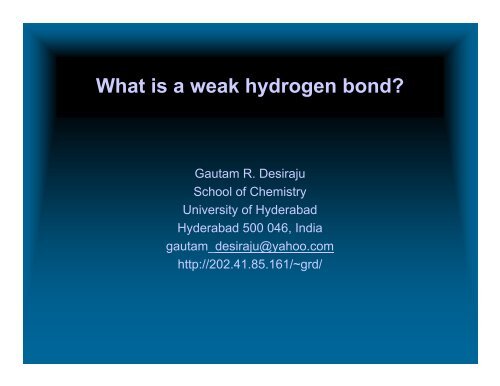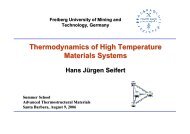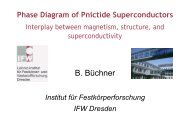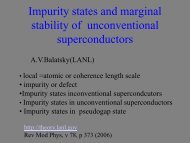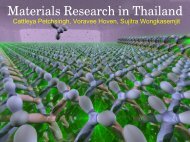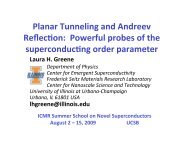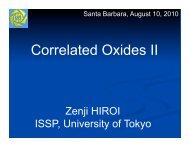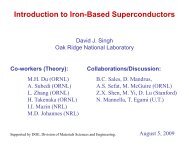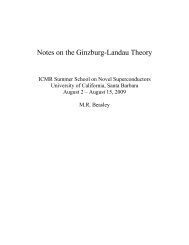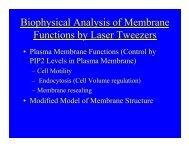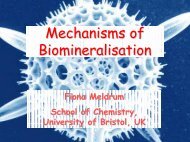What is a weak hydrogen bond?
What is a weak hydrogen bond?
What is a weak hydrogen bond?
You also want an ePaper? Increase the reach of your titles
YUMPU automatically turns print PDFs into web optimized ePapers that Google loves.
<strong>What</strong> <strong>is</strong> a <strong>weak</strong> <strong>hydrogen</strong> <strong>bond</strong>?<br />
Gautam R. Desiraju<br />
School of Chem<strong>is</strong>try<br />
University of Hyderabad<br />
Hyderabad 500 046, India<br />
gautam_desiraju@yahoo.com<br />
http://202.41.85.161/~grd/
<strong>What</strong> <strong>is</strong> a <strong>hydrogen</strong> <strong>bond</strong>?<br />
Under certain conditions an atom of <strong>hydrogen</strong> <strong>is</strong><br />
attracted by rather strong forces to two atoms<br />
instead of only one, so that it may be considered<br />
to be acting as a <strong>bond</strong> between them (Pauling, 1939).<br />
D—H …….. A
Other <strong>hydrogen</strong> <strong>bond</strong> definitions, X–H…A<br />
A <strong>hydrogen</strong> <strong>bond</strong> <strong>is</strong> said to ex<strong>is</strong>t when (1) there<br />
<strong>is</strong> evidence of a <strong>bond</strong>, and (2) there <strong>is</strong> evidence<br />
that th<strong>is</strong> <strong>bond</strong> sterically involves a <strong>hydrogen</strong> atom<br />
already <strong>bond</strong>ed to another atom.<br />
Pimentel and McClellan (1960)<br />
Any cohesive interaction where H carries a<br />
positive charge and A a negative charge (partial<br />
or full) and the charge on H <strong>is</strong> more positive<br />
than on X<br />
Steiner and Saenger (1993)
Eccentricities of nomenclature<br />
D—H…….A<br />
H accepts electrons<br />
A donates electrons<br />
H donates a <strong>hydrogen</strong> <strong>bond</strong><br />
A accepts a <strong>hydrogen</strong> <strong>bond</strong><br />
DONOR<br />
ACCEPTOR
Weak (or non-conventional) <strong>hydrogen</strong> <strong>bond</strong>s<br />
H<strong>is</strong>torical survey, 1937-1982.<br />
1937. Glasstone. Cl 3 C–H…O=CMe 2 complex<br />
1939. Pauling definition<br />
1962. Sutor and the C–H…O <strong>hydrogen</strong> <strong>bond</strong>. (Nature).<br />
1967. Oki and Iwamura. O–H…π interactions (JACS)<br />
1968. Donohue critic<strong>is</strong>m of Sutor<br />
1976. Le<strong>is</strong>erowitz review on carboxylic acids (Acta Cryst)<br />
1982. Taylor–Kennard paper (JACS)
The <strong>weak</strong> <strong>hydrogen</strong> <strong>bond</strong> <strong>is</strong><br />
an interaction X–H···A wherein<br />
a <strong>hydrogen</strong> atom forms a <strong>bond</strong><br />
between two structural moieties<br />
X and A, of which one or even<br />
both are of moderate to low<br />
electronegativity (1999)
Bibliography<br />
• G. R. Desiraju and T. Steiner, The Weak Hydrogen<br />
Bond in Structural Chem<strong>is</strong>try and Biology, OUP,<br />
Chichester, 1999.<br />
• G. A. Jeffrey, An Introduction to Hydrogen Bonding,<br />
OUP, New York, 1997.<br />
• G. R. Desiraju, Acc. Chem. Res., 24, 270,1991.<br />
• G. R. Desiraju, Acc. Chem. Res., 29, 441,1996.<br />
• G. R. Desiraju, Acc. Chem. Res., 35, 565,2002.<br />
• G. R. Desiraju, Chem. Comm., 2996, 2005.<br />
• T. Steiner, Cryst. Rev., 6, 1, 1996.
Different types of <strong>hydrogen</strong> <strong>bond</strong><br />
D—H …….. A<br />
D—H ……….. A<br />
Very strong<br />
Strong<br />
D—H ……….…. A<br />
Weak
Hydrogen <strong>bond</strong><br />
Any cohesive interaction X–H•••A where H carries a<br />
positive and A a negative (partial or full) charge and<br />
the charge on X <strong>is</strong> more negative than on H<br />
O–H···O(-) O–H···O N–H···O<br />
O–H···π N–H···π C–H···O<br />
Os–H···O C–H···Ni C–H···π
How to assess <strong>hydrogen</strong> <strong>bond</strong>s?<br />
• Energy<br />
• Spectroscopy<br />
• Geometry<br />
• Structure<br />
• Function<br />
A complex interaction
Very strong<br />
Strong<br />
Weak<br />
[F–H…F] –<br />
N–H…O=C<br />
C–H…O<br />
Energy –15 to –40 – 4 to – 15 < – 4<br />
IR, ν s >25% 5-25%
Cl 3–n R n C–H…O<br />
G. R. Desiraju, J. Chem. Soc., Chem. Comm., 179, 1989
Angles, X–H…O
IR bathochromic shifts, C–H…O<br />
G. R. Desiraju and B. N. Murty, Chem. Phys. Lett., 139, 360, 1987
Cooperativity<br />
O<br />
H<br />
O<br />
H<br />
O<br />
H<br />
R<br />
R<br />
R<br />
O<br />
H<br />
O<br />
H<br />
O<br />
Anti-cooperative<br />
R<br />
R
C–H…O cooperativity in ethynyladamantan-2-ol<br />
r 1 –r 2 = 0.025(14) Å<br />
Allen et al., J. Am. Chem. Soc., 118, 4081, 1996
Thermal parameters
Isostructurality<br />
Et<br />
Et<br />
O<br />
O<br />
H<br />
N<br />
N<br />
H<br />
O<br />
2.31<br />
2.05<br />
H<br />
H<br />
H<br />
N<br />
N<br />
H<br />
O<br />
Et<br />
Et<br />
O<br />
O<br />
H<br />
N<br />
N<br />
H<br />
O<br />
2.56<br />
2.01<br />
H<br />
H<br />
H<br />
H<br />
N<br />
H<br />
O
Two molecules in the asymmetric unit (Z’=2)<br />
H<br />
H<br />
H<br />
O<br />
H<br />
Me 2<br />
N<br />
H<br />
O<br />
O<br />
H<br />
H<br />
O<br />
CH 3<br />
Me 2<br />
N
Electronegativity and Hardness<br />
Fluorine<br />
C—H ……….…. F—C<br />
Weak donor<br />
Very <strong>weak</strong> acceptor
C–H···F–C Interactions in Fluorobenzenes<br />
F<br />
F<br />
F<br />
F<br />
F<br />
F<br />
F<br />
F<br />
F<br />
F<br />
F<br />
F<br />
F<br />
F<br />
F<br />
F<br />
F<br />
F<br />
F<br />
F<br />
F<br />
Thalladi, Weiß et al, JACS, 120, 8702, 1998
C–H···F–C Hydrogen Bonds<br />
All C, H, F compounds<br />
Fluorobenzenes
Weak and reversible C–H···F–C Hydrogen Bridge<br />
Applications. Polymerization catalyst.<br />
F<br />
Zr +<br />
F<br />
F<br />
H<br />
H<br />
Boron adducts<br />
Lancaster et al, Chem. Comm.,<br />
2148, 2003<br />
Stereoselective polymer<strong>is</strong>ation<br />
Chan et al,<br />
Angew. Chem. Int. Ed.,<br />
42, 1628, 2003<br />
Decrease of β-H transfer<br />
T. Fujita et al,<br />
JACS, 124, 3327, 2002<br />
JACS, 125, 4293, 2003
Weak and reversible C–H···F–C Hydrogen Bridge<br />
Applications. Molecular recognition.<br />
Binding in thrombin<br />
Diederich et al,<br />
Angew. Chem. Int. Ed.,<br />
42, 2507, 2003
Hydrogen bridge (Wasserstoffbrücke)<br />
Electrostatics<br />
Charge transfer<br />
(covalency)<br />
D<strong>is</strong>persion/repulsion<br />
(van der Waals)<br />
Polar<strong>is</strong>ation<br />
A composite interaction
Covalent limit (40 kcal/mol)<br />
O H<br />
R R<br />
H 2<br />
N<br />
O H O PO(OH) 2<br />
H 2<br />
N<br />
O H N CH 3<br />
Cl 5<br />
O<br />
X H X<br />
[HF 2<br />
] -<br />
very strong <strong>hydrogen</strong> <strong>bond</strong>s<br />
strong <strong>hydrogen</strong> <strong>bond</strong>s<br />
<strong>weak</strong> <strong>hydrogen</strong> <strong>bond</strong>s<br />
NH 4+<br />
⋅⋅⋅F −<br />
NH 4+<br />
RCOO −<br />
NH 4+<br />
⋅⋅⋅Cl − NMe 4+<br />
⋅⋅⋅X −<br />
Electrostatic limit<br />
(15 kcal/mol)<br />
OH⋅⋅⋅O=C<br />
NH⋅⋅⋅O=C<br />
NH 4+<br />
⋅⋅⋅π<br />
(NO2 ) 3<br />
CH⋅⋅⋅O<br />
OH⋅⋅⋅OH<br />
NH⋅⋅⋅NH<br />
OsH⋅⋅⋅O≡C<br />
Cl 3<br />
CH⋅⋅⋅O=CMe 2<br />
C≡CH⋅⋅⋅OH<br />
NH⋅⋅⋅S<br />
CH⋅⋅⋅Cl −<br />
OH⋅⋅⋅π<br />
NH⋅⋅⋅π<br />
C=CH⋅⋅⋅O<br />
CH⋅⋅⋅S<br />
C≡CH⋅⋅⋅π<br />
NH⋅⋅⋅Co<br />
Ph⋅⋅⋅Ph<br />
CH 4<br />
⋅⋅⋅π<br />
very <strong>weak</strong><br />
interactions<br />
CH⋅⋅⋅FC CH 4<br />
⋅⋅⋅Ar<br />
CH⋅⋅⋅ClC<br />
van der Waals limit<br />
(0.25 kcal/mol)
Hydrogen <strong>bond</strong><br />
D—H …….. A<br />
A composite interaction that spans wide ranges of<br />
geometry and energy<br />
Great chemical variations among the donor D—H and<br />
acceptor A groups<br />
However, all <strong>hydrogen</strong> <strong>bond</strong>s have several features in<br />
common<br />
Notably, their effect on crystal structure and packing
•Students<br />
•Post-doctorals<br />
•Collaborators<br />
•University of Hyderabad<br />
•DST, CSIR, DRDO


